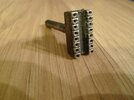sounds like a double sided plated through PC board.
To remove parts from boards like this, you really need to have a desoldering iron.
using the squeeze bulb, or solder wick, or the plastic solder sucker can lead to problems.
these PC boards have a little metal sleeve that connects the hole on the bottom of the board to the hole on the top of the board, and if you don't get all the solder out of the hole, when you go to pull the part out, you'll pull the sleeve out with it.
you'll see it on the component lead.
ask me how i know this LOL.
Having a desoldering iron that will heat the trace, and being able to just push a button to suck out all the solder is night and day different than the other methods.
now, not everyone is going to be ready and able to drop the coin for one of these irons, so there is a method that can work, but i will warn that the possibility of trace damage is still there.
the idea is to 'rock' the part out of the board by putting your soldering iron on one trace, leaning the part over the other direction to raise the lead up into the board a bit, then move over to the other component lead and lean the part the other way.
moving back and forth you will eventually have one lead come out the top of the board, and then you can heat the remaining lead and pull the part.
HOWEVER!
you have to be careful and let the solder cool in the hole that you just heated before you move over to the other hole, because if you don't, when you go to lean the part over, you'll push the lead back through toward the bottom of the board and possibly lift the trace up.
if you do accidentally pull the sleeve out, you can just mount the new part so that there is some lead showing on the top of the board, and then just get some solder on the top of the component lead as well as on the bottom.
hope that helps.
LC



